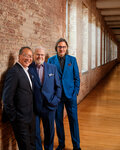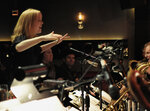



(This story has been updated to correct a photo caption that misidentified cellist Yo-Yo Ma as pianist Emanuel Ax and vice versa.)
MONDAY, May 1 — He’s bringing down the Ax (Emanuel Ax), bringing out the Blow (Kurtis Blow) and pulling out the stops. Ten months into his tenure as the fourth executive director of the Wharton Center for the Performing Arts, Eric Olmscheid has finally gotten to unveil his own performing arts slate, after inheriting last year’s schedule from predecessor Michael Brand.
Wharton’s 2023-‘24 fine arts season was announced today. Tickets go on sale at 10 a.m. as part of a subscription package. For more information, see www.whartoncenter.com/events.
In his previous gig as director of Des Moines Performing Arts, Olmscheid booked a diverse array of genre-blurring artists. He has done the same at Wharton, from the indigenous Indian and Pacific island troupe “Small Island, Big Song” (March 21) to a “Hip-Hop Nutcracker” (Dec. 6) emceed by old school rap legend Kurtis Blow himself.
Classical and jazz highlights include the super-trio of pianist Emanuel Ax, cellist Yo-Yo Ma and violinist Leonidas Kavakos (Jan. 31), the return of the Detroit Symphony Orchestra under its dynamic new music director, Jader Bignamini (May 2, 2024); young Taiwanese-Australian violin virtuoso Ray Chen (March 16) and one of the most creative and ambitious large ensembles in jazz history, the Maria Schneider Orchestra, making its Wharton debut Feb. 23.
Un-stuffy and adventurous artists like jazz saxophonist Immanuel Wilkins (Dec. 8) and live-wire string quartet Publiquartet (April 25) will be showcased in a new, 100-seat venue listening room series within the Wharton Center, dubbed Club 750.
In Des Moines, Olmscheid scored a big success with Live at the Temple, a series similar to Club 750, that showcased top jazz, classical and crossover artists that are best heard in an informal, small-room setting.
Olmscheid said he kept two goals in mind as he put the season together. On stage, he wanted artists that would “resonate” with Wharton’s core audience. Behind the scenes, he sought out artists that would help to extend the facility’s educational “tentacles” (in his word) into the community, with master classes, residencies, workshops and other programs embedded in MSU, greater Lansing and mid-Michigan.
On stage or in the classroom, Olmscheid wanted to present a roster of artists representing the “broad spectrum” of human faces, art forms and musical styles now flourishing on the performing arts scene.
It was a coup among coups for Wharton to snag Maria Schneider and her orchestra. Schneider, an ambitious and brilliant composer who writes for every size ensemble, is in constant demand around the world as guest conductor of her own compositions. Her ambitious 2020 magnum opus “Data Lords” is a deep dive into the divide between the digital and natural worlds. Schneider’s ability to hold a large ensemble together for over 30 years, playing almost entirely new music, is a miracle.
In addition to Schneider, Wharton’s jazz series will feature a jazz tribute to Disney Oct. 18 and the local debut of Catherine Russell, a powerful vocalist who specializes in muscling vintage jazz and blues songs to life, at the Pasant Theatre April 16.
Another major coup for Wharton, the Ax-Ma-Kavakos triumvirate, was the first date Olmscheid nailed down when he took command at Wharton last year. (Talks were already underway before Olmscheid’s arrival.)
It’s a summit meeting of three towering artists who play with the rapport and grit of a “garage band,” in Ma’s disarming description.
“It’s a very limited run, and it’s hard to get a date,” Olmscheid said. “They’re three of the premier classical musicians of our time right now.”
The Detroit Symphony visit is officially a one-shot, but Olmscheid said the Wharton Center is “rekindling” its 30-year-old relationship with the DSO, under its new leadership at the podium (Bignamini, appointed in 2021) and in the front office (president and CEO Erik Rönmark, appointed in 2022), with more visits likely.
Unlike previous orchestral concerts at the Wharton Center, when assistant conductors took the podium for touring dates, Bignamini himself will conduct the orchestra and vibrant new DSO concertmaster Robyn Bollinger will solo on violin. Instead of the usual conservative, big-orchestra-touring-in-Cowtown repertoire, the evening will blaze with Argentinian tango master Astor Piazzolla’s athletic violin concerto, “The Four Seasons of Buenos Aires,” paired with “More Seasons,” a new work by Michael Abels, composer of the scores for Jordan Peele’s films “Get Out” and “Us.”
“It’s an opportunity to showcase two of Michigan’s finest musicians, and its one of the world’s oldest symphony orchestras,” Olmscheid said.
As the performing arts blur and diversify into myriad hybrids and offshoots, the traditional classical concert is clearly not going away. Olmscheid said he’s heard the “same narrative about traditional or classical art forms dying” since he started working in the industry 20 years ago, yet two of Wharton’s mainstream classical events this season, cellist Alisa Weilerstein and the New York Philharmonic String Quartet, were packed with young attendees.
“We’re seeing a huge boom in young people enjoying classical music and traditional art forms,” Olmscheid said.
Snagging 34-year-old virtuoso Ray Chen (March 16), a stunning violinist who plays social media as adeptly as he plays Jascha Heifetz’s 1714 “Dolphin” Stradivarius (don’t worry, it’s on loan), will probably help the Wharton Center push that trend even further.
The performing arts scene is crowded with talented voices whose energy tends to dissipate in a huge hall and are best heard in a smaller and less formal setting than the Wharton’s Cobb Great Hall or Pasant Theatre.
After the success of the informal listening-room Live at the Temple series in Des Moines, Olmscheid couldn’t wait to launch a similar venue at the Wharton Center.
“Club 750” (a nod to the Wharton Center’s address at 750 E. Shaw Lane) will convert the glassy, 100-seat Jackson Lounge, often used for receptions and pre-concert events, into a venue similar in atmosphere to Dizzy’s Club Coca-Cola at Lincoln Center in New York.
The club will feature cabaret tables, bar service and other lounge-y trappings.
Olmscheid said the venue is meant to “create space in our main series for artists that may not have the name recognition or draw typically associated with a main stage act, but are remarkable, talented musicians we want to showcase.”
Club 750 will showcase genre-defying artists like Gabriel Royal (Nov. 9), a charismatic singer-songwriter-cellist who captivates listeners in subways and public spaces as well as major concert venues.
Saxophonist Immanuel Wilkins, one of the most celebrated young jazz musicians in jazz, will bring his quartet to the club Dec. 8. Martha Redbone, a galvanizing singer-songwriter with a dual Native American and African-American heritage, brings a unique mélange of folk, blues and gospel with her Roots Project Feb. 15.
“These artists are expanding genres, expanding where we can go,” Olmscheid said.
That’s doubly true of PubliQuartet, an adventurous string quartet dedicated to new music.
PubliQuartet is noted for imaginative and thoughtful improvisations and extensions of music by jazz icons as diverse as Ornette Coleman, Fats Waller, Alice Coltrane and Roscoe Mitchell. They’ll bring a mélange of classical, jazz, bluegrass and folk to Club 750 April 25.
“They’re doing such interesting things in the classical chamber space that I think it’s important to elevate,” Olmscheid said. “But it’s newer work, it’s contemporary work, so that intimate space is the right size, and I’m thrilled to have a space where we can present it.”
Club 750 not only expands the roster of artists available to the Wharton Center, it also makes use of the building on nights when rehearsals or performances are scheduled in the other two venues.
The first of a grab-bag of diverse “variety events” will open Wharton’s 41st season on Sept. 20: “Mandy Gonzalez: Fearless,” a cabaret-style show at the Pasant Theatre. Broadway star Mandy Gonzalez rocketed to fame after appearing in Lin-Manuel Miranda’s “In the Heights” and “Hamilton.”
It’s a far cry from Emanuel Ax, let alone Kurtis Blow, but “Dixie’s Tupperware Party” (Oct. 19-20) was a hit several times over for Olmscheid in Des Moines. He’s sure the homespun, comedic revue will appeal to mid-Michigan audiences.
"Air Play,” (Jan. 26), a colorful and gravity-defying exploration of the invisible stuff that floats above the ground, is the non-verbal brainchild of husband and wife circus performers Christina Gelsone and Seth Bloom, who delight in sending balloons, umbrellas and fabric fantasias hither and thither on stage.
Humorist David Sedaris makes a fifth appearance at Wharton Oct. 24, reading selections from his most recent book along with unpublished material.
A head-turning trio of holiday shows reflects the diversity of the season as a whole. “Hip-Hop Nutcracker” (Dec. 6) is a music and dance fantasia based on Tchaikovsky’s classic ballet, emceed in person by no less a legend than old school rapper Kurtis Blow. Updating the “Nutcracker” is almost an industry in itself, and why not? After all, Mr. Blow taught us long ago that “this ain’t eighteen-twenty-three; ain’t even nineteen-seventy.” (Blow’s “Christmas Rappin’” was the first rap song released on a major label.)
On Dec. 12, Voctave, an 11-member a cappella vocal group from Orlando, will serve up a “Broadway-Disney” take on holiday music. To cap off Wharton’s holiday events Dec. 18-20, Cirque Dreams presents “Holidaze,” a Broadway-style holiday spectacle performed by an offshoot ensemble of Cirque de Soleil.
All of the artists visiting Wharton will do some form of education and outreach work.
Two groups will do extended residencies, with classes, workshops and school performances. Step Afrika (performing March 9) will bring the tradition of South African, stepping, tap and other dance traditions.
Small Island, Big Song, (performing March 21) is a troupe of indigenous musicians from islands in the Indian and Pacific oceans that are facing existential threats from climate change.
Olmscheid really lights up when he talks about the multi-pronged extravaganza slated for Nov. 17. A 40-foot-wide movie screen will be plastered in front of the Great Hall for a full screening of “Harry Potter and the Sorcerer’s Stone,” with the Lansing Symphony Orchestra, playing John Williams’ soundtrack, live and in real time.
“You forget how many humans it takes to play a movie score like that until they’re live, in front of you,” Olmscheid said.
It’s expensive and cumbersome to host a full symphony performance in the 2020s, but Olmscheid wanted two “core” orchestras to come to Wharton in his first season as director — the Detroit Symphony and the hometown Lansing Symphony — and he got them both.
In keeping with past practice, Olmscheid is open to snagging tantalizing performing artists on short notice and adding them to the calendar, but the stars will have to line up just right on both ends.
“Frankly, the calendar is full,” Olmscheid said. “We’ve booked over 250 performances for the year, but whenever we can, we’ll add in additional performances.”
Support City Pulse - Donate Today!
Comments
No comments on this item Please log in to comment by clicking here